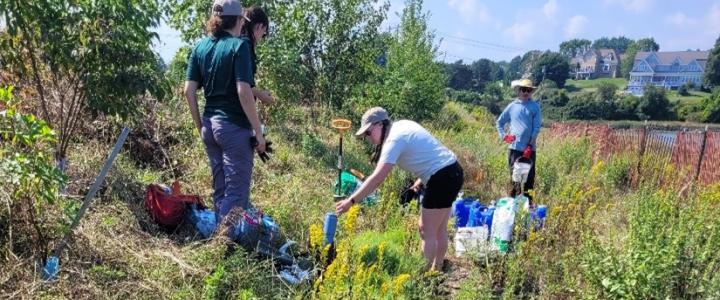
Geese Beware: Living Shoreline is here to stay!
Earlier this year, on a hot, early September afternoon, NHDES Coastal Program staff members Becca Katz and Polly Crocker arrived at Cutts Cove in Portsmouth to assist in a salt marsh restoration effort by planting 2,000 plugs of Distichlis spicata, commonly known as spike grass. The University of New Hampshire (UNH) developed the Cutts Cove restoration plan in 2016, after the Route 1 Bridge expansion project, using funds awarded from the New Hampshire Aquatic Resource Mitigation (ARM) Fund.
This multihabitat restoration project began in 2017 to create 600 new feet of natural shoreline, and 6,000 square feet of salt marsh habitat in what was formerly a steep 10- to 12-foot riprap wall. This nature-based approach is called a living shoreline and supports stabilization in tidal waters. Approximately 12% of New Hampshire’s tidal shoreline is armored with some sort of engineered structure, such as riprap. These traditional armored shoreline structures, however, impede salt marsh migration, negatively impact shoreline stability, habitat condition, and other ecosystem services, and can potentially fail during major storms if not maintained, according to the NH Living Shoreline Site Suitability Assessment.
A living shoreline provides erosion control benefits by protecting, restoring or enhancing the natural shoreline habitat, and maintaining the natural coastal processes through the strategic placement of plants and other organic materials. These projects are typically hybrid designs that use minimal hardscape materials to ensure stability while maximizing native natural conditions that will over time provide greater ecological and infrastructure protection than a solely hardened shoreline. This project included a 1- to 3-foot riprap sill to reduce wave energy and even within a few years, the rock sill acts like a rocky intertidal habitat that has been almost fully colonized by Fucus and Ascophyllum rockweed and barnacles.
Salt marshes are transitional habitats from ocean to land where fresh and saltwater mix. There are several zones that have plants adapted to varying levels of salt tolerance from the fluctuating water levels from the tides, which is why certain species are planted in specific areas. At the beginning of this Cutts Cove project, volunteers and staff planted over 6,200 plugs of Spartina alterniflora (smooth cordgrass), in the low marsh; 1,650 plugs of Spartina patens (saltmeadow cordgrass), and 350 plugs of Juncus gerardii (saltmarsh rush) in the high marsh; and 20 plugs of both Panicum virgatum (switchgrass) and Spartina pectinata (prairie cordgrass) in the high marsh-upland border.
Not all went as planned, however. In 2020, monitoring staff found the low marsh had been feasted on by Canada Geese during the November-December migration. The geese had an appetite for the nutrient-rich roots and rhizomes of the freshly installed, yet not fully established, plants. In response, project partners built a plastic fence around the perimeter of the low marsh, but the damage was already done. In 2023, with money from the ARM Fund, the low marsh was replanted in May with 8,000 plugs of the smooth cordgrass, and 2,000 plugs of the spike grass were added to the high marsh in September. Additionally, the fencing was rebuilt with stronger wooden snow fencing.
The vegetation monitoring was concluded in early October, and the low marsh appears to have rebounded over this past growing season. The spike grass enjoyed the rainy summer as well. Luckily, geese like smaller plants, so as the marsh becomes more robust, there is less concern about damage from them. So far, the geese do not appear to be decimating the new plants, nevertheless the game cameras will continue to monitor over this year’s goose migration.
Thanks to Grant McKown and Dr. Dave Burdick at the Jackson Estuarine Lab at UNH, Dr. Tom Ballestero of UNH and Streamworks, and the many volunteers who helped plant, including several NHDES interns and staff, Cutts Cove is looking more resilient than ever!




